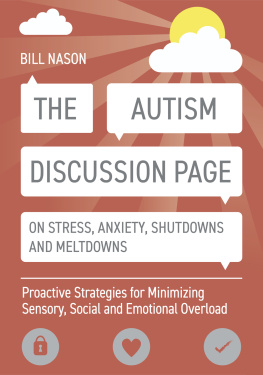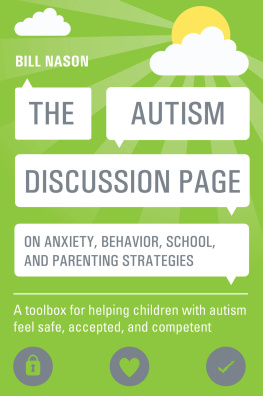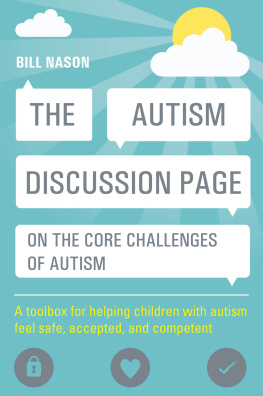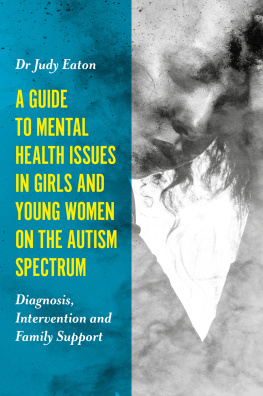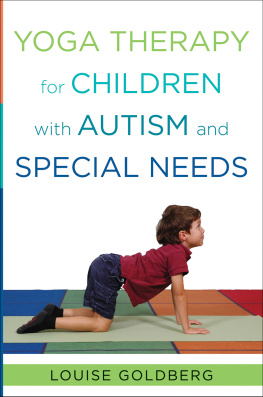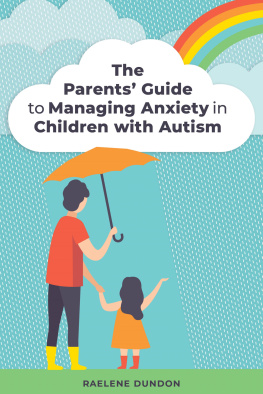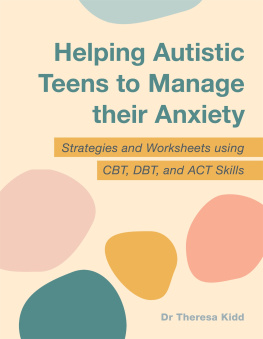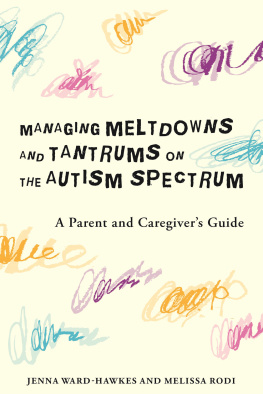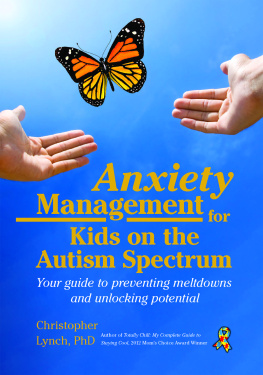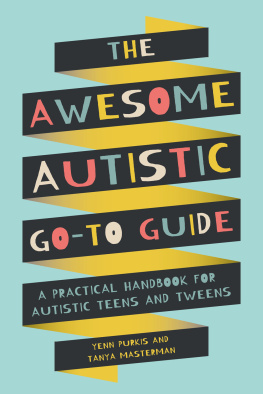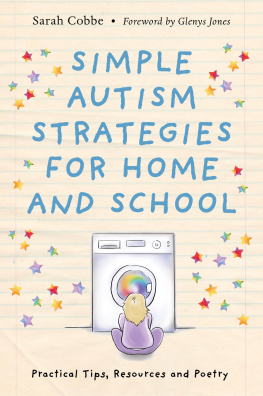
THE AUTISM
DISCUSSION PAGE
ON STRESS, ANXIETY, SHUTDOWNS
AND MELTDOWNS
Proactive Strategies for Minimizing
Sensory, Social and Emotional Overload
BILL NASON

Jessica Kingsley Publishers
London and Philadelphia
Contents
INTRODUCTION
Welcome to the third publication in the Autism Discussion Page series. My name is Bill Nason and I am a retired mental health professional with over 35 years of experience in the field of developmental disabilities and autism spectrum disorders. Over the years, I provided psychological, consultant services to families, community settings, schools, mental health agencies and individuals with autism. In addition, I took part in numerous training seminars and speaking engagements, and volunteered for local autism support groups and coaching sessions with recreational sports programs for children with autism.
Approximately eight years ago I developed the Autism Discussion Page on Facebook. Over the years, I developed a variety of PowerPoint slide presentations that I used for speaking engagements. These presentations consist of a toolbox of strategies for helping children on the spectrum feel safe, accepted and competent. My thought was to post these presentations on the Facebook page and lead some educational discussions around these presentations. I naively anticipated a membership of 300400 parents, teachers and professionals who were interested in supporting those with autism. Little was I aware of the power and reach of Facebook and how fast the page would grow. Today we have over 175,000 members on the Autism Discussion Page, spanning the whole world and bringing together a host of parents, teachers, professionals and others who support those with autism. The page quickly turned into a three-hours-a-day commitment, with me writing two to three posts a day and responding to numerous comments, questions and messages. Today, the page provides a resource for thousands of parents, teachers, professionals and individuals with autism themselves, a place where we share knowledge, experiences, suggestions and support.
Autism Discussion Page book series
Approximately five years ago, with the encouragement of our page members, we expanded the information from the Facebook page into the Autism Discussion Page book series. At the time, the initial two-volume series was a collection of narrative articles posted on the page, organized into an easy-to-read toolbox of strategies for supporting those with autism. To date, we have sold over 25,000 copies of the books, and had excellent reviews from parents, teachers, professionals and individuals with autism. Many parents and professionals report that the two-book series is their major go-to resource for helping those they support. Instead of the books being labeled volume I and II respectively, they are usually referred to by their colors: blue and green.
(Blue book) The Autism Discussion Page on the Core Challenges of Autism: A Toolbox for Helping Children with Autism Feel Safe, Accepted, and Competent (Nason 2014a).
This book provides an in-depth view of the four basic sensory, cognitive, social and emotional areas of vulnerabilities for individuals on the spectrum. There is a comprehensive view of each area of vulnerability with detailed guidelines on how to support the child through these challenges. When readers are finished, they will have a good understanding of how their children perceive the world, process information and act the way they do. The book takes you through all the sensory challenges that are common for those on the spectrum, how they process information differently, why they struggle so much socially, and how overwhelming their emotional world can be. From this awareness, it becomes easier to understand and accept those with autism, as well as help them regulate our world. Whether you are a parent, teacher, professional or someone on the spectrum yourself, this book will be of value to you.
(Green book) The Autism Discussion Page on Anxiety, Behavior, School, and Parenting Strategies: A Toolbox for Helping Children with Autism Feel Safe, Accepted, and Competent (Nason 2014b).
This book covers some of the major challenges that children and families experience during their daily routine and how to address each challenge. We cover stress and anxiety, addressing behavior issues, co-occurring conditions, stretching comfort zones, harnessing strengths and preferences, parenting and discipline strategies, teaching empowerment skills, and a host of mentoring strategies for coaching your child in basic life skills.
(Brown Book) The Autism Discussion Page on Stress, Anxiety, Shutdowns and Meltdowns: Proactive Strategies for Minimizing Sensory, Social and Emotional Overload.
This book analyzes the daily stressors that people with autism experience, the draining effects that tax their nervous systems and the resultant stress, anxiety, shutdowns and meltdowns. Trying to navigate a world that presents them with many challenges results in ongoing physical, mental and emotional drain, continually taxing their processing skills and leaving them vulnerable to sensory, social and emotional overload. Understanding these processing differences allows us to make modifications and accommodations to better match the expectations and demands of their daily routine to their processing abilities, thus making the world more autism friendly. This book will provide proactive strategies for minimizing stress, anxiety, meltdowns and burnout.
This third book expands on the information from the previous two books, focusing on topics that were of most interest to our members on the Facebook page (stress, anxiety, sensory issues, social challenges and meltdowns). describes autism as an information processing difference, explaining what the differences are and how to help reduce the challenges these differences present.
presents and analyzes the seven major factors that render events taxing, how to appraise events for their processing strain and ways to minimize the mental and emotional drain. Both chapters combine to match the environmental demands to the processing needs of the individual.
teaches the reader the difference between stress and distress. Stress is inevitable and manageable, but distress is the ultimate enemy to avoid. It explains how both stress and distress affect the person, overwhelming their processing and damaging their abilities. Strategies provide guidelines for minimizing stress and avoiding distress.
discusses specific coping strategies for managing anxiety during stressful situations. Although anxiety is a major co-occurring condition in autism, it can be managed effectively with both proactive, preventative strategies and coping skills for tackling anxiety.
looks at the relationship between anxiety and rigid/inflexible thinking, showing how anxiety and cognitive/emotional rigidity go hand and hand. Rigid and inflexible thinking, obsessive thoughts and compulsive behaviors are often driven by anxiety. Strategies are offered to lessen rigidity and build greater flexibility.
looks at those who experience severe anxiety associated with oppositional behavior and demand avoidance. To these individuals, the world is so frightening that they need to control everything happening to them and around them. This requires us to minimize all demands, let them lead, and become collaborative, working partners with them.
discuss shutdowns and meltdowns (10), how to prevent them (11) and how to support individuals during meltdowns (12)what they are, the differences between the two, ways to avoid them and proactive strategies for minimizing the turmoil when they occur. These chapters aim to make meltdowns understandable, predictable and manageable.
Next page
